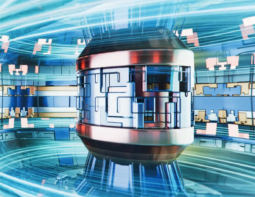Stiffer, more robust device developed in response to customer demand, says UHV Design engineering director Jonty Eyres
Vacuum technology is routinely used in both scientific research and industrial processes. In physics, high-quality vacuum systems make it possible to study materials under extremely clean and stable conditions. In industry, vacuum is used to lift, position and move objects precisely and reliably. Without these technologies, a great deal of research and development would simply not happen. But for all its advantages, working under vacuum does come with certain challenges. For example, once something is inside a vacuum system, how do you manipulate it without opening the system up?

The UK-based firm UHV Design has been working on this problem for over a quarter of a century, developing and manufacturing vacuum manipulation solutions for new research disciplines as well as emerging industrial applications. Its products, which are based on magnetically coupled linear and rotary probes, are widely used at laboratories around the world, in areas ranging from nanoscience to synchrotron and beamline applications. According to engineering director Jonty Eyres, the firm’s latest innovation – a new sample transfer arm released at the beginning of this year – extends this well-established range into new territory.
“The new product is a magnetically coupled probe that allows you to move a sample from point A to point B in a vacuum system,” Eyres explains. “It was designed to have an order of magnitude improvement in terms of both linear and rotary motion thanks to the magnets in it being arranged in a particular way. It is thus able to move and position objects that are much heavier than was previously possible.”
The new sample arm, Eyres explains, is made up of a vacuum “envelope” comprising a welded flange and tube assembly. This assembly has an outer magnet array that magnetically couples to an inner magnet array attached to an output shaft. The output shaft extends beyond the mounting flange and incorporates a support bearing assembly. “Depending on the model, the shafts can either be in one or more axes: they move samples around either linearly, linear/rotary or incorporating a dual axis to actuate a gripper or equivalent elevating plate,” Eyres says.
Continual development, review and improvement
While similar devices are already on the market, Eyres says that the new product has a significantly larger magnetic coupling strength in terms of its linear thrust and rotary torque. These features were developed in close collaboration with customers who expressed a need for arms that could carry heavier payloads and move them with more precision. In particular, Eyres notes that in the original product, the maximum weight that could be placed on the end of the shaft – a parameter that depends on the stiffness of the shaft as well as the magnetic coupling strength – was too small for these customers’ applications.
“From our point of view, it was not so much the magnetic coupling that needed to be reviewed, but the stiffness of the device in terms of the size of the shaft that extends out to the vacuum system,” Eyres explains. “The new arm deflects much less from its original position even with a heavier load and when moving objects over longer distances.”
The new product – a scaled-up version of the original – can move an object with a mass of up to 50 N (5 kg) over an axial stroke of up to 1.5 m. Eyres notes that it also requires minimal maintenance, which is important for moving higher loads. “It is thus targeted to customers who wish to move larger objects around over longer periods of time without having to worry about intervening too often,” he says.
Moving multiple objects
As well as moving larger, single objects, the new arm’s capabilities make it suitable for moving multiple objects at once. “Rather than having one sample go through at a time, we might want to nest three or four samples onto a large plate, which inevitably increases the size of the overall object,” Eyres explains.
Before they created this product, he continues, he and his UHV Design colleagues were not aware of any magnetic coupled solution on the marketplace that enabled users to do this. “As well as being capable of moving heavy samples, our product can also move lighter samples, but with a lot less shaft deflection over the stroke of the product,” he says. “This could be important for researchers, particularly if they are limited in space or if they wish to avoid adding costly supports in their vacuum system.”




